What is Mendelian Inheritance/Mendel’s Laws of Inheritance?
- Mendelian inheritance refers to the set of principles that describe how traits are transmitted from parents to their offspring through genes. These principles, formulated by Gregor Mendel, are the cornerstone of classical genetics and provide a systematic way to predict patterns of inheritance.
- Mendel’s work, conducted in the mid-19th century, focused on garden pea plants. He selected specific traits like flower color, seed shape, and plant height, and studied how these traits appeared across generations. His experiments revealed that certain traits follow distinct patterns of inheritance.
- Mendel’s first key principle is the Law of Segregation, which states that each organism carries two alleles for each trait, one from each parent. These alleles separate during the formation of gametes (sperm or egg cells), so each gamete contains only one allele for each trait. This explains why offspring inherit one genetic factor from each parent, ensuring genetic diversity.
- The second principle, the Law of Independent Assortment, explains that genes for different traits segregate independently of one another during gamete formation. This law applies when genes for traits are located on different chromosomes. Therefore, the inheritance of one trait does not influence the inheritance of another.
- Additionally, Mendel’s third concept, the Law of Dominance, explains how some alleles can mask the presence of others. For each trait, one allele can be dominant, meaning it will determine the organism’s appearance, while the other allele can be recessive and will only appear if both alleles are recessive.
- Although Mendel’s contributions were initially ignored, his work was rediscovered in the early 20th century, providing a foundation for modern genetics. His laws are still used today to explain inheritance patterns, although we now know that more complex patterns of inheritance, like incomplete dominance and codominance, also exist.
Genetics Terminology of Mendelian inheritance
These terms clarify how genes operate, how traits are inherited, and the relationship between genetic information and observable characteristics.
- Gene: A gene is a segment of DNA that holds the instructions for determining specific traits or characteristics in an organism. Each gene occupies a specific location on a chromosome and directs the production of proteins that ultimately influence how an organism looks or functions.
- Allele: Alleles are different versions of the same gene. For example, for the gene controlling flower color, one allele may code for purple flowers, while another may code for white flowers. Each individual inherits two alleles for each gene, one from each parent.
- Genotype: The genotype refers to the complete set of alleles an organism possesses. It determines the potential traits an individual can pass to its offspring. For a specific gene, if the two inherited alleles are the same, the organism is homozygous for that gene. If the alleles differ, the organism is heterozygous.
- Phenotype: This is the observable expression of a trait, such as the color of a flower or the shape of a seed. The phenotype results from the interaction between the genotype and the environment, although some traits are largely determined by genetic factors alone.
- Dominant Allele: A dominant allele is an allele that masks the effect of a recessive allele when both are present in the genotype. For instance, if the allele for round seeds is dominant and the allele for wrinkled seeds is recessive, a plant with both alleles will display round seeds.
- Recessive Allele: A recessive allele is one that is only expressed in the phenotype when two copies of it are present. In heterozygous organisms, the recessive trait is not visible, but it can be passed to offspring.
- Locus: The locus is the specific physical location of a gene or allele on a chromosome. Each gene has a defined locus, which remains consistent across individuals of a species.
- Carrier: A carrier is an individual who has one dominant allele and one recessive allele for a trait. While the dominant allele determines the phenotype, the recessive allele can still be passed to offspring, potentially appearing in future generations if the offspring inherit two recessive alleles.
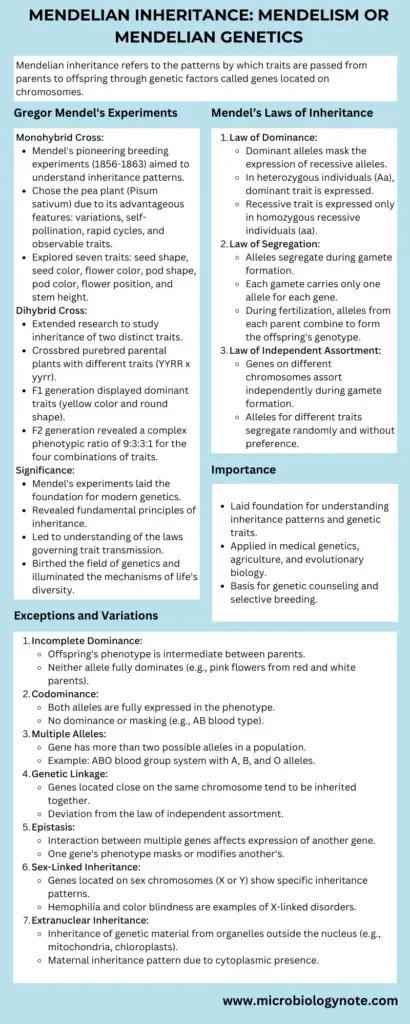
Mendel’s Experiment
Gregor Mendel’s experiments between 1856 and 1863 laid the foundation for our understanding of genetic inheritance. Using the pea plant (Pisum sativum), he identified patterns of how traits are passed from one generation to the next. Mendel’s work, which focused on breeding experiments, revealed significant insights into inheritance, leading to what we now refer to as Mendel’s Laws of Inheritance.
Why Mendel Chose Pea Plants
Mendel selected pea plants for several key reasons:
- Availability of varieties: Pea plants came in distinct forms with clear variations, such as seed color and pod shape.
- Self-pollination capability: Pea plants naturally self-pollinate, ensuring controlled reproduction and reducing the risk of unintended traits mixing.
- Short life cycle: This allowed Mendel to observe multiple generations in a short period.
- Ease of cultivation: Pea plants grow easily, making them ideal for controlled experiments.
- Distinct traits: Mendel focused on seven easily distinguishable traits: seed shape, seed color, flower color, pod shape, pod color, flower position, and stem height.
Mendel’s Key Experiments
Mendel carried out two major types of genetic crosses:
1. Monohybrid Cross
- Focus: Inheritance of a single trait.
- Example: Cross between tall plants (TT) and dwarf plants (tt).
- Generations:
- Parental Generation (P): The initial organisms used in the cross.
- First Filial Generation (F1): Offspring from the parental generation.
- In the F1 generation, all offspring displayed the dominant trait (tallness). The recessive trait (dwarfness) was completely masked.
- Second Filial Generation (F2): Offspring produced from the F1 generation’s self-pollination.
- In the F2 generation, both dominant and recessive traits appeared in a 3:1 ratio, meaning for every three tall plants, there was one dwarf plant.
Observations from Monohybrid Cross:
- Dominant and Recessive Traits: The dominant trait masks the recessive trait in the F1 generation but reappears in the F2 generation.
- Consistency Across Traits: Mendel’s experiments showed that this 3:1 ratio applied to all seven traits he studied, confirming a predictable inheritance pattern.
2. Dihybrid Cross
- Focus: Inheritance of two traits simultaneously.
- Example: Cross between plants with yellow, round seeds (YYRR) and plants with green, wrinkled seeds (yyrr).
- Generations:
- F1 Generation: All plants exhibited the dominant traits (yellow and round seeds).
- F2 Generation: Traits reappeared in a phenotypic ratio of approximately 9:3:3:1, indicating the independent assortment of these traits.
Observations from Dihybrid Cross:
- Independent Assortment: Traits are passed down independently of one another, leading to various combinations in the offspring.
- Phenotypic Ratio: The F2 generation displayed a 9:3:3:1 ratio, meaning nine offspring showed both dominant traits, three showed one dominant and one recessive trait, three showed the reverse combination, and one showed both recessive traits.
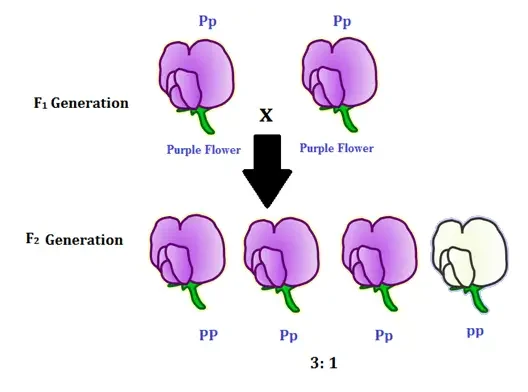
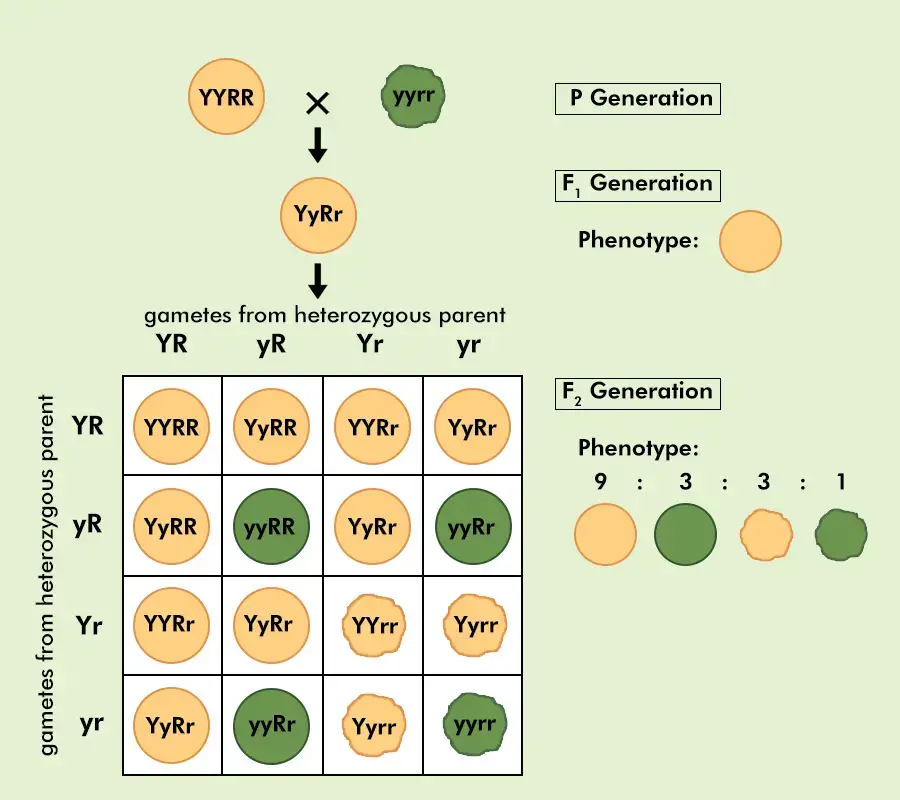
Mendel’s Laws of Inheritance or Mendel’s Principles of Inheritance
Gregor Mendel’s pioneering work on pea plants led to the establishment of three fundamental laws of inheritance, which form the foundation of classical genetics. These laws explain how traits are inherited from one generation to the next and describe the predictable patterns of trait transmission. The laws are the Law of Dominance, the Law of Segregation, and the Law of Independent Assortment.
1. Law of Dominance
- Definition: The Law of Dominance states that when two different alleles (alternative forms of a gene) are present in an organism, one allele is dominant and the other is recessive. In a heterozygous pairing, the dominant allele is expressed, while the recessive allele remains hidden or unexpressed.
- Example: In Mendel’s monohybrid cross between tall (TT) and dwarf (tt) pea plants, the F1 generation exhibited only tall plants, reflecting the dominance of the tall allele (T) over the recessive dwarf allele (t). Therefore, this law explains how dominant traits override recessive traits in hybrid offspring.
- Function: The Law of Dominance serves to clarify how parental traits are manifested in offspring, particularly in heterozygous organisms.
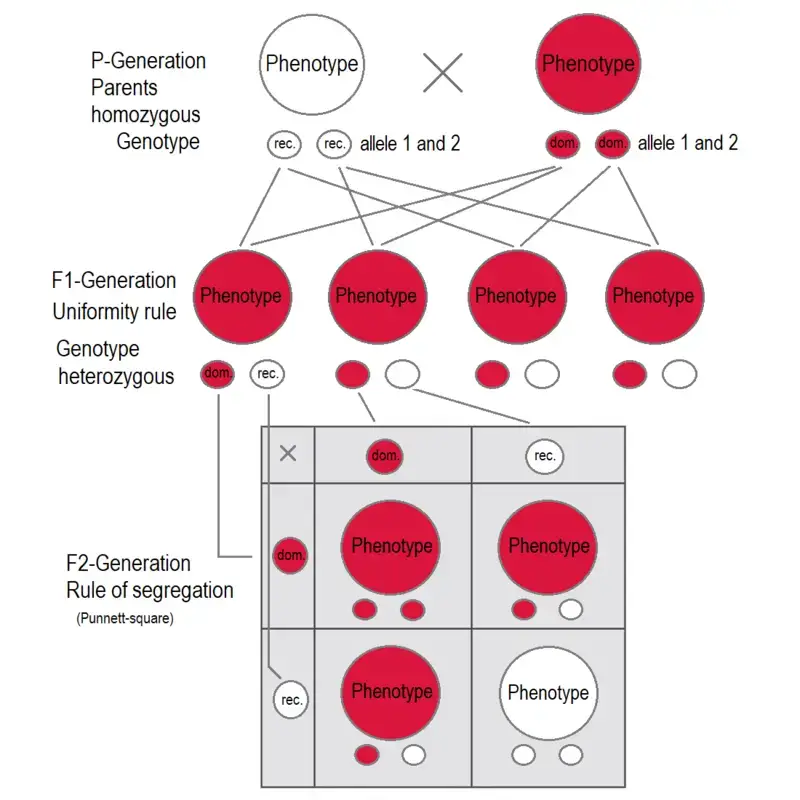
2. Law of Segregation (Law of Purity of Gametes)
- Definition: The Law of Segregation explains how alleles separate during the formation of gametes (sperm and egg cells). Each organism carries two alleles for each trait, one inherited from each parent. During gamete formation, these alleles segregate, and each gamete receives only one allele for each trait.
- Example: In Mendel’s F2 generation of the monohybrid cross, the reappearance of the recessive trait (dwarfness) showed that the alleles for tallness and dwarfness separated during gamete formation. Thus, each gamete carried either the tall or dwarf allele, resulting in a 3:1 ratio of tall to dwarf plants in the F2 generation.
- Function: This law highlights the mechanism of allele separation during meiosis, ensuring genetic diversity by allowing different combinations of alleles in the offspring.
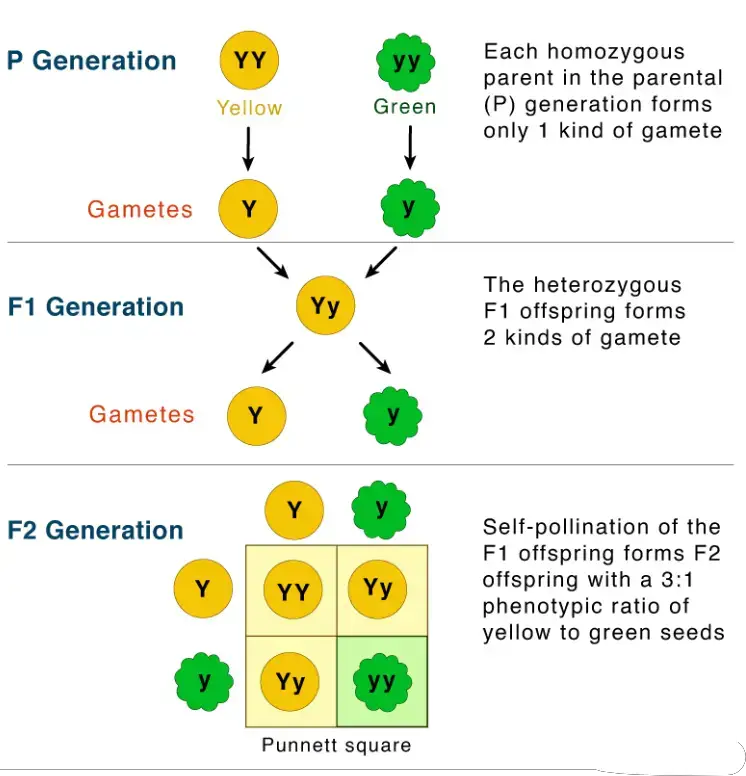
3. Law of Independent Assortment
- Definition: The Law of Independent Assortment states that alleles for different traits are distributed to gametes independently of one another. This means that the inheritance of one trait does not influence the inheritance of another.
- Example: In Mendel’s dihybrid cross involving two traits—seed color (yellow or green) and seed shape (round or wrinkled)—the F2 generation exhibited a phenotypic ratio of 9:3:3:1. This indicated that the alleles for seed color assorted independently from those for seed shape.
- Function: The Law of Independent Assortment emphasizes the random distribution of alleles for different traits, contributing to the variety of possible genetic combinations in offspring.
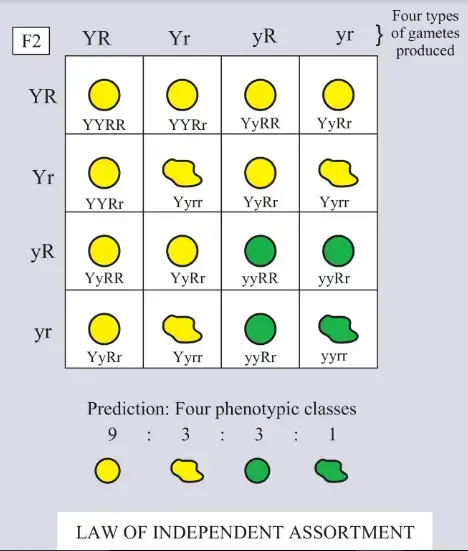
Law of Segregation vs. Law of Independent Assortment
The Law of Segregation and the Law of Independent Assortment are fundamental principles of Mendelian inheritance that describe the behavior of alleles during the process of gamete formation and the inheritance of multiple traits. Here’s a breakdown of these two laws:
Law of Segregation: The Law of Segregation, also known as the Law of Purity of Gametes, governs how alleles for a particular trait separate during the formation of gametes (sperm and egg cells). It was discovered by Gregor Mendel through his experiments with pea plants. This law emphasizes that:
- During meiosis, the process of gamete formation, each parent contributes one allele for a specific trait to each offspring.
- The alleles carried by an individual for a particular trait segregate from each other during gamete formation, so that each gamete carries only one allele for that trait.
- This ensures that when fertilization occurs, the offspring inherit one allele from each parent, resulting in the genetic diversity and variability necessary for evolution.
- The segregation of alleles is random and unbiased, meaning that neither allele has an advantage or is favored during the separation process.
Law of Independent Assortment: The Law of Independent Assortment describes how alleles for different traits segregate and assort independently of each other during gamete formation. This principle is closely related to the distribution of alleles from different genes into gametes. Key points of this law include:
- Alleles located on different chromosomes assort independently, meaning that the inheritance of one trait does not influence the inheritance of another trait.
- The independent assortment occurs due to the random alignment of homologous chromosomes along the metaphase plate during meiosis I.
- The possible combinations of alleles in gametes are numerous, leading to increased genetic diversity in the offspring.
- This law contributes to the uniqueness of each individual and the variability within populations.
In summary, the Law of Segregation emphasizes the separation of alleles for a single trait during gamete formation, ensuring each offspring inherits one allele from each parent. The Law of Independent Assortment underscores the random and independent distribution of alleles for different traits into gametes, resulting in diverse combinations of traits in offspring. Both laws play a crucial role in shaping the genetic diversity within populations and are essential for understanding inheritance patterns in organisms.
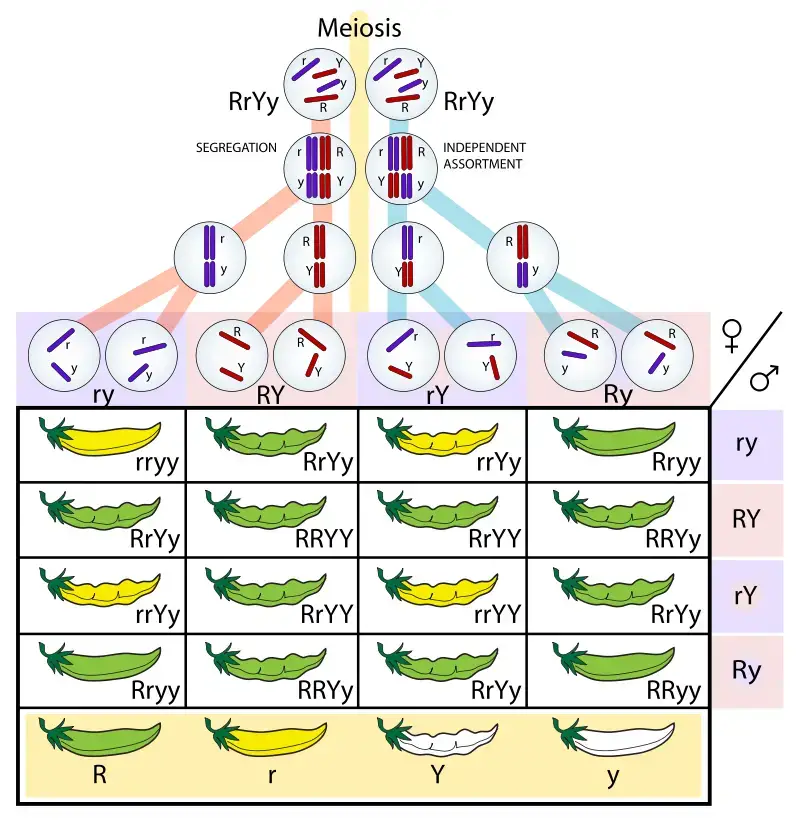
| Law of Segregation | Law of Independent Assortment |
|---|---|
| Definition: | Definition: |
| Alleles for a specific trait | Alleles for different traits segregate |
| segregate during gamete formation. | and assort independently during gamete |
| formation. | |
| Process: | Process: |
| During meiosis, each parent | During meiosis I, alleles located on |
| contributes one allele for a | different chromosomes align independently |
| specific trait to each offspring. | along the metaphase plate. |
| Outcome: | Outcome: |
| Offspring inherit one allele from | Genetic diversity is increased in |
| each parent for a particular trait. | offspring due to numerous combinations |
| of alleles in gametes. | |
| Randomness: | Randomness: |
| Segregation of alleles is random | Independent assortment leads to random |
| and unbiased; neither allele is | combinations of alleles in gametes, |
| favored during separation. | without influence from other traits. |
In summary, the Law of Segregation emphasizes the separation of alleles for a single trait during gamete formation, while the Law of Independent Assortment underscores the random and independent distribution of alleles for different traits into gametes. Both laws contribute to genetic diversity and are crucial for understanding inheritance patterns.
Pedigrees to Study Inheritance Patterns
Pedigree analysis is a valuable tool used by geneticists to study the inheritance patterns of human genetic diseases. It provides insights into how traits are passed down through generations within families, helping individuals understand their risk of inheriting or passing on specific genetic disorders.
Understanding Genetic Inheritance:
- Many human diseases have a genetic basis, meaning they are caused by specific gene mutations inherited from parents.
- For individuals in families with a history of genetic disorders, it’s important to determine if they carry disease-causing genes and assess the risk of passing the disorder to their children.
- Inherited disorders can follow different patterns of inheritance, including autosomal recessive, autosomal dominant, X-linked recessive, and others.
Pedigree Analysis:
- Pedigrees are visual representations of family trees that track the occurrence of specific traits or disorders across generations.
- In pedigrees, each generation is represented by a row, and individuals are depicted using symbols (circles for females, squares for males).
- Relationships between individuals are shown with connecting lines, indicating marriages and parent-offspring relationships.
- Pedigrees allow geneticists to analyze patterns of inheritance, identify carriers of disease-causing alleles, and predict the likelihood of an individual being affected by a genetic disorder.
Pedigree Components:
- Affected Individuals: Those with the genetic disorder are represented by shaded symbols. The presence of the disorder in an individual’s lineage is indicated by a shaded circle or square.
- Carriers: Individuals who carry a disease-causing allele but do not exhibit symptoms are represented by half-shaded symbols (half-filled circles or squares).
- Unaffected Individuals: Those without the genetic disorder are depicted with clear symbols.
- Generations: Rows in the pedigree represent different generations of the family, with the oldest generation at the top.
- Relationships: Horizontal lines connect mating partners, and vertical lines extend downward to connect parents with their offspring.
Interpreting Pedigrees:
- Pedigrees reveal inheritance patterns, helping geneticists determine if a disorder is recessive, dominant, or X-linked.
- Autosomal Recessive: Typically appears in multiple generations, skips generations, and affects males and females equally.
- Autosomal Dominant: Appears in each generation, affects males and females equally, and often has an affected parent.
- X-Linked Recessive: More common in males, can skip generations, and is often passed from carrier females to their sons.
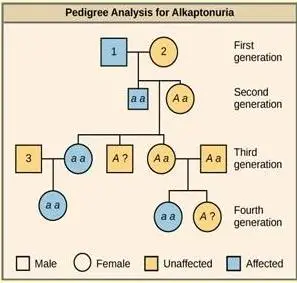
Alkaptonuria is a recessive genetic disorder that impairs the metabolism of phenylalanine and tyrosine amino acids. Affected individuals can exhibit darkened skin, brown urine, and may suffer from joint damage and other complications. A pedigree illustrates the inheritance of this disorder, where affected individuals are shown in blue and have the genotype aa, while unaffected individuals are depicted in yellow with the genotypes AA or Aa.
Key Points:
- Alkaptonuria is a recessive genetic disorder causing issues with phenylalanine and tyrosine metabolism.
- Affected individuals can display skin darkening, brown urine, joint problems, and other complications.
- Pedigrees visually represent family inheritance patterns, aiding the study of genetic disorders.
- Affected individuals are indicated in blue and have the aa genotype (homozygous recessive).
- Unaffected individuals are depicted in yellow and can have either AA (homozygous dominant) or Aa (heterozygous) genotypes.
- Genotypes of individuals can be inferred from those of their offspring.
- If a child has the disorder but neither parent does, both parents must be heterozygous carriers (Aa).
- Individuals with an unaffected phenotype but unknown genotype are represented as “A?” since they must have at least one normal allele.
This pedigree highlights how analyzing family trees can provide insights into genetic disorders’ inheritance patterns and aid in determining the genotypes of individuals based on the traits they pass down to their offspring.
Example:
- A pedigree for a human genetic disease illustrates how the disorder is passed down through generations.
- Affected individuals are shaded, carriers are half-shaded, and unaffected individuals are clear.
- Relationships are depicted through connecting lines, highlighting parent-offspring and marital connections.
Pedigree analysis plays a crucial role in understanding genetic disorders within families and communities. By studying the patterns of inheritance, geneticists can provide valuable information for individuals making informed decisions about their health and family planning.
Non-Mendelian inheritance
- Non-Mendelian inheritance refers to the inheritance patterns of traits that deviate from the expectations set by Mendel’s laws. These laws, proposed by Gregor Mendel, outline how traits associated with single genes on chromosomes within the nucleus segregate during reproduction. In Mendelian inheritance, each parent contributes one of two possible alleles for a trait to their offspring. By knowing the genotypes of the parents in a genetic cross, Mendel’s laws can predict the distribution of phenotypes among their offspring. However, there are instances where the observed proportions of phenotypes in the progeny differ from the predicted values.
- Non-Mendelian inheritance scenarios challenge these straightforward predictions and encompass various mechanisms that influence trait transmission. These mechanisms often involve complex genetic interactions, such as multiple genes affecting a single trait, or genetic traits being influenced by factors beyond nuclear DNA.
- Non-Mendelian inheritance plays a significant role in several genetic diseases and conditions. Some disorders are caused by mutations in genes that don’t adhere to Mendelian inheritance patterns, making the inheritance and expression of these traits more intricate. Additionally, certain diseases are impacted by factors such as mitochondrial DNA, genomic imprinting, or polygenic inheritance, all of which lead to deviations from classical Mendelian ratios.
- In summary, non-Mendelian inheritance encompasses a wide array of genetic scenarios that don’t conform to the simple rules of Mendel’s laws. These complex genetic interactions are vital to understanding the full spectrum of inheritance patterns, especially in cases where diseases and conditions are influenced by a combination of genetic factors beyond the scope of Mendelian genetics.
Types
Non-Mendelian inheritance encompasses various patterns of genetic inheritance that do not adhere to the straightforward principles outlined by Mendel’s laws. These deviations introduce complexity to the understanding of how traits are passed down from one generation to the next. Several types of non-Mendelian inheritance are recognized, each involving unique genetic interactions:
- Incomplete Dominance: Incomplete dominance challenges the principle of dominance proposed by Mendel. Instead of a dominant allele fully masking the recessive allele, both alleles contribute to the phenotype, resulting in an intermediate expression. For example, in Mirabilis jalapa and Antirrhinum majus, flower color demonstrates incomplete dominance.
- Co-dominance: Co-dominance defies the traditional dominance-recessiveness relationship between alleles. Both alleles are equally expressed in the phenotype, allowing both traits to be observed simultaneously. Co-dominance is exemplified by certain chicken varieties with co-dominant alleles for black and white feathers, as well as the ABO blood group system in humans.
- Genetic Linkage: Genetic linkage deviates from Mendel’s principle of independent assortment. When genes are located near each other on the same chromosome, they tend to be inherited together, which contradicts the expected independent segregation of alleles during meiosis.
- Multiple Alleles: Multiple alleles involve genes that possess more than two variations within a population. Unlike Mendel’s experiments that focused on traits regulated by only two alleles, multiple alleles demonstrate the existence of several different forms of a gene. The ABO blood group system in humans, with its three alleles (A, B, and O), illustrates multiple alleles.
- Epistasis: Epistasis involves the interaction of multiple genes, where one gene’s expression influences or masks the expression of another gene. This contrasts with Mendel’s laws, as it showcases the interconnectedness of genetic pathways and how the expression of one gene can modify another gene’s expression.
- Sex-Linked Inheritance: Genetic traits located on sex chromosomes exhibit specific non-Mendelian patterns. Sex-linked inheritance encompasses traits influenced by genes on the X and Y chromosomes, affecting males and females differently. Examples include color blindness and hemophilia.
- Extranuclear Inheritance (Cytoplasmic Inheritance): Extranuclear inheritance involves genetic information present in organelles like mitochondria and chloroplasts, which is passed down through the cytoplasm of maternal gametes. Disorders like mitochondrial diseases exemplify this mode of inheritance.
- Polygenic Traits: Polygenic traits result from the interaction of multiple genes and exhibit a wide range of phenotypes. Skin color and eye color in humans are examples of polygenic traits influenced by multiple genes.
- Genomic Imprinting: Genomic imprinting involves genes that are marked epigenetically before transmission, altering their expression levels. Imprints are created before gamete formation and can result in the exclusive expression of certain alleles depending on parental origin.
- Trinucleotide Repeat Disorders: Trinucleotide repeat disorders, such as Fragile X syndrome and Huntington’s disease, result from the expansion of microsatellite tandem repeats. These disorders display non-Mendelian inheritance patterns as the number of repeats changes across generations.
These diverse forms of non-Mendelian inheritance underscore the intricate genetic interactions that shape the inheritance of traits and contribute to the complexity of genetic inheritance patterns beyond Mendel’s classical laws.
Modes of Inheritance
In genetics, the term “modes of inheritance” refers to the ways in which genetic traits or disorders are passed from one generation to the next. Mendelian inheritance patterns are categorized primarily into three major types: autosomal dominant, autosomal recessive, and X-linked inheritance. Each mode of inheritance has distinct characteristics that influence the likelihood of offspring inheriting a specific trait or disease.
1. Autosomal Dominant Inheritance
- Definition: Autosomal dominant inheritance occurs when a single copy of a dominant allele is sufficient to express a particular trait or disease. The dominant allele is located on one of the autosomes (non-sex chromosomes), meaning it can be passed on from either parent.
- Characteristics:
- An affected individual only needs to inherit one dominant allele from either parent to exhibit the trait or disease.
- There is a 50% chance that an affected parent will pass the dominant allele to each offspring.
- The trait is expressed in both males and females with equal frequency since it is located on an autosome.
- Examples: Huntington’s disease, which affects the nervous system, and Marfan syndrome, a connective tissue disorder, are classic examples of autosomal dominant conditions.
- Function: This mode of inheritance highlights the role of dominant alleles in determining phenotypes, even when only one allele is altered.
2. Autosomal Recessive Inheritance
- Definition: Autosomal recessive inheritance requires two copies of an abnormal recessive allele for the trait or disease to be expressed. Individuals who inherit only one copy of the recessive allele are considered carriers but do not show any symptoms.
- Characteristics:
- Both parents must carry one copy of the abnormal allele for there to be a risk of having an affected child.
- Each child of two carrier parents has a 25% chance of inheriting both copies of the recessive allele, resulting in expression of the trait or disease.
- The trait affects both males and females equally, as it is also located on the autosomes.
- Carriers, with one normal and one abnormal allele, typically do not show any symptoms but can pass the abnormal allele to their offspring.
- Examples: Cystic fibrosis, a disorder that affects the lungs and digestive system, and sickle cell anemia, which impacts red blood cells, are well-known autosomal recessive conditions.
- Function: This inheritance pattern emphasizes the necessity of both alleles being altered for a recessive trait to manifest in an individual.
3. X-Linked Inheritance
- Definition: X-linked inheritance involves genes located on the X chromosome. Since males have one X chromosome and one Y chromosome, any gene on the X chromosome will be expressed in males, whether it is dominant or recessive. Females, who have two X chromosomes, may carry an abnormal gene on one X chromosome but remain unaffected if the other X chromosome carries a normal version of the gene.
- Characteristics:
- In males, the presence of a single altered X-linked gene results in expression of the trait or disease, as they do not have a second X chromosome to compensate.
- Females with one altered X-linked gene are typically carriers, meaning they can pass the trait to their offspring without showing symptoms.
- Affected males will pass the X-linked gene to all of their daughters but none of their sons, since sons inherit the Y chromosome from their father.
- Examples: Hemophilia, a disorder that affects blood clotting, and color blindness, which affects color perception, are examples of X-linked recessive conditions.
- Function: This mode of inheritance explains why certain conditions, particularly X-linked recessive traits, are more commonly expressed in males than females.
Exceptions and Deviation from Mendel’s Findings
Gregor Mendel’s pioneering work established foundational principles in the field of genetics, including the laws of segregation and independent assortment. However, subsequent research has identified several deviations from Mendelian inheritance patterns, revealing a more nuanced understanding of genetic processes. These deviations include incomplete dominance, co-dominance, multiple alleles, genetic linkage, and epistasis. Each phenomenon illustrates the complexity of genetic inheritance beyond Mendel’s original framework.
1. Incomplete Dominance
- Definition: Incomplete dominance occurs when the phenotype of the offspring is a blend of the parental phenotypes. This arises when neither allele is completely dominant over the other.
- Mechanism: Unlike Mendel’s principle of dominance, where one allele masks the other, incomplete dominance results in an intermediate expression of traits. For instance, in snapdragon flowers, crossing red-flowered plants with white-flowered plants produces offspring with pink flowers, demonstrating an intermediate phenotype.
- Example: Snapdragon flower color, where the red (R) and white (W) alleles combine to produce pink (RW) flowers.
2. Co-Dominance
- Definition: Co-dominance is a genetic scenario where both alleles are fully expressed, and neither allele is dominant over the other. This results in a phenotype that simultaneously shows traits from both alleles.
- Mechanism: This contrasts with Mendelian dominance, where one allele overrides the expression of the other. In co-dominance, both traits are visible.
- Example: Blood type inheritance in humans. The A and B alleles are co-dominant, leading to the presence of both A and B antigens in individuals with AB blood type.
3. Multiple Alleles
- Definition: Multiple alleles refer to a situation where a gene has more than two allelic forms within a population, expanding the variation beyond Mendel’s two-allele model.
- Mechanism: Mendel’s experiments typically involved genes with only two alleles. However, real-world genes often exhibit more complexity.
- Example: The ABO blood group system involves three alleles—A, B, and O—which interact to determine an individual’s blood type. The combinations of these alleles contribute to the variety in blood types observed in humans.
4. Genetic Linkage
- Definition: Genetic linkage occurs when genes located on the same chromosome are inherited together more frequently than would be expected if they assorted independently.
- Mechanism: This phenomenon contradicts Mendel’s law of independent assortment, which states that genes on different chromosomes segregate independently. Genes that are close together on the same chromosome tend to be inherited together due to reduced likelihood of recombination between them.
- Example: The linkage of genes for eye color and wing size in fruit flies, where these traits are often inherited together rather than independently.
5. Epistasis
- Definition: Epistasis is a form of gene interaction where the expression of one gene influences or masks the expression of another gene. This interaction deviates from Mendelian inheritance by involving multiple genes.
- Mechanism: In epistasis, one gene can suppress or modify the effect of another gene. This is distinct from Mendelian inheritance patterns where genes are considered to have discrete, non-interacting effects.
- Example: In Labrador retrievers, the gene controlling pigment color (B) is influenced by a separate gene that controls pigment deposition (E). An epistatic interaction occurs when the E gene affects the expression of the B gene, leading to variations in coat color.
Why Was the Pea Plant Selected for Mendel’s Experiments?
The following factors explain why the pea plant was particularly suited for Mendel’s research:
1. Availability of Varieties with Observable Traits
- Diverse Phenotypes: The pea plant offers numerous varieties with distinct and easily observable alternative forms of traits. Mendel utilized these varieties to analyze different genetic characteristics.
- Trait Examples: Observable traits in pea plants include seed color (yellow vs. green), pod color (green vs. yellow), pod shape (inflated vs. constricted), and plant height (tall vs. short).
- Function: These distinct phenotypes allowed Mendel to track and categorize inheritance patterns with high precision.
2. Self-Pollination and Controlled Cross-Pollination
- Self-Pollination: Pea plants are naturally self-pollinated, as their flowers have mechanisms to ensure that pollination occurs within the same flower, leading to a controlled genetic environment.
- Mechanism: The corolla of the pea flower fully encloses the reproductive organs, reducing the likelihood of cross-pollination by external agents.
- Cross-Pollination: Despite their self-pollinating nature, peas can also be cross-pollinated, allowing Mendel to manually control and study hybridization.
- Function: This ability to both self and cross-pollinate provided Mendel with the flexibility to investigate both inbreeding and hybridization.
3. Accessibility and Ease of Cultivation
- Practical Considerations: Pea plants are readily available and easy to grow, making them a practical choice for extensive experimental work.
- Cultivation: They can be cultivated annually with minimal care, except during the critical pollination phase.
- Function: This ease of cultivation allowed Mendel to maintain large experimental populations and conduct multiple generations of breeding.
4. Distinct Contrasting Characters
- Clear Genetic Variations: Pea plants exhibit clear, contrasting characters that are ideal for studying inheritance patterns.
- Trait Examples: These include seed shape (round vs. wrinkled), flower position (axial vs. terminal), and plant height (tall vs. dwarf).
- Function: The presence of these distinct characteristics facilitated Mendel’s analysis of how traits are passed from one generation to the next and helped establish the foundational principles of genetic inheritance.
5. Short Life Cycle and High Seed Production
- Rapid Generation Turnover: The pea plant has a relatively short life cycle, which enables the observation of multiple generations within a limited timeframe.
- Seed Production: Pea plants produce a large number of seeds per generation.
- Function: The short life cycle and high seed yield allowed Mendel to accumulate sufficient data quickly and observe genetic patterns over successive generations.
Importance of Mendelian Inheritance
Mendelian inheritance, also known as Mendelism or Mendelian genetics, holds significant importance in the field of biology and genetics for several reasons:
- Foundation of Genetics: Mendel’s experiments with pea plants laid the groundwork for understanding the principles of heredity and how traits are passed from one generation to another. His work marked the beginning of modern genetics.
- Predictive Power: Mendelian inheritance provides a framework for predicting the likelihood of specific traits appearing in offspring based on the genotypes of the parents. This predictability is crucial in agriculture, animal breeding, and even in human genetics for genetic counseling.
- Basis for Genetic Studies: Mendel’s laws serve as a starting point for studying various genetic phenomena, including linkage, recombination, and mutation. These laws help scientists decipher the mechanisms underlying genetic traits and diseases.
- Clinical Relevance: Understanding Mendelian inheritance is essential for diagnosing and treating genetic disorders. It allows for the prediction of inheritance patterns, carrier status, and risk assessment for certain diseases in individuals and families.
- Population Genetics: Mendelian principles play a role in population genetics and evolutionary biology. They contribute to the understanding of how traits can change over time in a population through mechanisms like natural selection.
- Basis for Genetic Research: Mendelian inheritance provided the foundation for subsequent genetic research, including the discovery of DNA as the genetic material and the development of techniques such as polymerase chain reaction (PCR) and gene sequencing.
- Genetic Engineering: The understanding of Mendelian genetics has paved the way for genetic engineering and biotechnology. Scientists can manipulate genes and organisms based on these principles, leading to advancements in agriculture, medicine, and other fields.
- Education and Outreach: Mendelian genetics is often introduced in basic biology education. It serves as an accessible way to introduce the concepts of inheritance, genes, and genetic variation to students of various ages.
- Ethical Considerations: The principles of Mendelian inheritance have implications for ethical discussions surrounding genetic testing, gene editing, and issues related to hereditary diseases.
- Building Blocks of Complex Traits: While Mendelian genetics describes simple inheritance patterns, understanding these foundational principles helps researchers unravel the genetics behind more complex traits, including those influenced by multiple genes and environmental factors.
List of Latest Research Work on Mendelian Inheritance
- Alkaptonuria: Current Perspectives
- Abstract: This research delves into the metabolic disorder alkaptonuria (AKU), which is caused by a deficiency of homogentisate dioxygenase (HGD). Sir Archibald Garrod used AKU to illustrate the concept of Mendelian inheritance in man. The study highlights the phase III clinical study SONIA 2, which tested the effectiveness and safety of nitisinone in the treatment of AKU. The results were positive, suggesting that a cure for AKU might be found by 2020. The research also touches upon the potential of enzyme replacement or gene therapy for AKU.
- Authors: A. Zaťková, L. Ranganath, L. Kádasi
- Publication Date: 2020-01-23
- Link to Full Paper
- A stroke gene panel for whole-exome sequencing
- Abstract: This research aimed to compile a comprehensive panel of genes associated with monogenic causes of stroke. The study systematically searched the Online Mendelian Inheritance in Man database and validated the entries against peer-reviewed publications. The resulting gene panel can be used to interpret exome sequencing results regarding monogenic stroke.
- Authors: A. Ilinca, Sofie Samuelsson, P. Piccinelli, M. Soller, U. Kristoffersson, A. Lindgren
- Publication Date: 2018-10-24
- Link to Full Paper
- Gene and Variant Annotation for Mendelian Disorders in the Era of Advanced Sequencing Technologies
- Abstract: The paper discusses the trends in research that aims to increase understanding of overall genomic complexity, complex inheritance patterns of disease, and patient-phenotype-specific genomic associations. It describes the emerging field of translational functional genomics and its role in the future of personalized medicine.
- Authors: S. Chakravorty, M. Hegde
- Publication Date: 2017-08-31
- Link to Full Paper
- Analysis of Mendelian inheritance and genetic linkage in microsatellite loci of Eucalyptus urophylla S.T. Blake
- Abstract: The study verified Mendelian inheritance, genetic linkage, and genotypic disequilibrium for 15 microsatellite loci in Eucalyptus urophylla. The results indicated that the analyzed set of microsatellite loci could be used for various genetic analyses in E. urophylla.
- Authors: S. Pupin, L. Rosse, I. C. Souza, J. Cambuim, C. Marino, M. Moraes, A. Sebbenn
- Publication Date: 2017-08-17
- Link to Full Paper
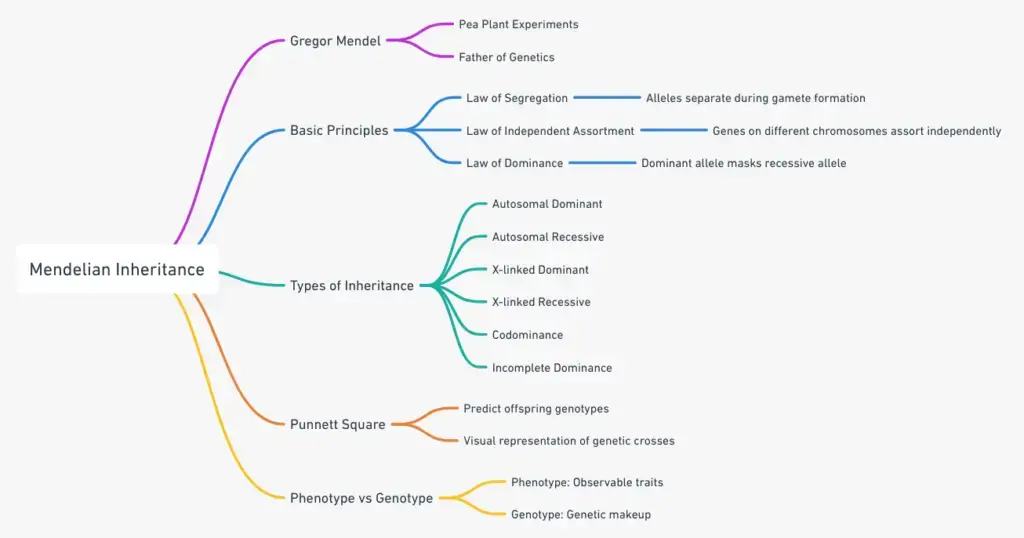
Practice MCQ on Mendelian Inheritance
What term is used to describe discrete units of hereditary information that are passed on from parents to offspring?
a) Genes
b) Alleles
c) Chromosomes
d) Proteins
Gregor Mendel conducted his groundbreaking experiments using which organism?
a) Dogs
b) Pea plants
c) Bacteria
d) Mice
In Mendelian inheritance, what is a gene composed of?
a) DNA sequence
b) RNA sequence
c) Protein sequence
d) Carbohydrate sequence
What is the term for a specific variant of a gene?
a) Phenotype
b) Chromosome
c) Allele
d) Locus
An organism with two different alleles for a particular gene is known as:
a) Homozygous
b) Heterozygous
c) Dominant
d) Recessive
According to the Law of Segregation, what happens during gamete formation?
a) Alleles for a gene segregate into separate gametes
b) Alleles for a gene blend together
c) Genes for different traits segregate together
d) Homologous chromosomes stay together
In a heterozygous individual, which allele’s phenotype is expressed?
a) Dominant allele
b) Recessive allele
c) Both alleles’ phenotypes are expressed equally
d) Neither allele’s phenotype is expressed
A person with the genotype Aa for a specific gene exhibits the dominant phenotype. What is the genotype of the individual’s parents?
a) AA and aa
b) Aa and Aa
c) Aa and aa
d) AA and Aa
What is the term for a gene that masks the expression of another gene?
a) Recessive gene
b) Dominant gene
c) Homozygous gene
d) Heterozygous gene
In Mendelian inheritance, when does co-dominance occur?
a) When one allele completely masks the expression of another
b) When two alleles are equally expressed in the phenotype
c) When one allele blends with another in the phenotype
d) When multiple alleles interact to produce a single phenotype
Answers:
a) Genes
b) Pea plants
a) DNA sequence
c) Allele
b) Heterozygous
a) Alleles for a gene segregate into separate gametes
a) Dominant allele
b) Aa and Aa
b) Dominant gene
b) When two alleles are equally expressed in the phenotype
FAQ
What is Mendelian inheritance?
Mendelian inheritance, also known as Mendelism, refers to the set of principles proposed by Gregor Mendel that explains how hereditary traits are passed from parents to their offspring through the transmission of genes.
Who was Gregor Mendel?
Gregor Mendel was an Austrian monk and botanist who conducted pioneering experiments with pea plants in the 19th century, leading to the formulation of the fundamental laws of inheritance now known as Mendel’s principles.
What are the three laws of Mendelian inheritance?
The three laws are the Law of Dominance, the Law of Segregation, and the Law of Independent Assortment. These laws govern how alleles (gene variants) are inherited and determine the expression of traits in offspring.
How does the Law of Dominance work?
The Law of Dominance states that one allele (dominant) will mask the expression of another allele (recessive) for a particular trait. Only when an individual is homozygous recessive will the recessive trait be expressed.
Explain the Law of Segregation.
The Law of Segregation states that during the formation of gametes (sperm and egg cells), the alleles for a trait segregate or separate from each other. As a result, each gamete carries only one allele for a specific trait.
What is the Law of Independent Assortment?
The Law of Independent Assortment states that alleles for different traits segregate independently during gamete formation. This principle explains how traits are inherited without being influenced by the inheritance of other traits.
What is the difference between genotype and phenotype?
Genotype refers to the genetic makeup of an organism, including the combination of alleles it carries. Phenotype refers to the observable traits or characteristics that result from the interaction between an organism’s genotype and its environment.
What is the significance of dominant and recessive alleles?
Dominant alleles express their phenotype even in heterozygous individuals, while recessive alleles require homozygosity to manifest their phenotype. Dominant alleles mask the expression of recessive alleles in heterozygotes.
Can traits be influenced by multiple genes?
Yes, many traits are controlled by multiple genes, a phenomenon known as polygenic inheritance. These traits often display a wide range of phenotypes due to the cumulative effects of multiple gene variants.
Are there exceptions to Mendelian inheritance?
Yes, there are instances of non-Mendelian inheritance, such as incomplete dominance, co-dominance, genetic linkage, and epistasis. These cases involve more complex inheritance patterns that deviate from the classical Mendelian principles.
References
- Harel, T., Pehlivan, D., Caskey, C. T., & Lupski, J. R. (2015). Mendelian, Non-Mendelian, Multigenic Inheritance, and Epigenetics. Rosenberg’s Molecular and Genetic Basis of Neurological and Psychiatric Disease, 3–27. doi:10.1016/b978-0-12-410529-4.00001-2
- “Principles of Genetics” by D. Peter Snustad and Michael J. Simmons
- “Introduction to Genetic Analysis” by Anthony J.F. Griffiths, Susan R. Wessler, Sean B. Carroll, and John Doebley
- “Genetics: Analysis and Principles” by Robert J. Brooker
- “Essentials of Genetics” by William S. Klug, Michael R. Cummings, Charlotte A. Spencer, and Michael A. Palladino
- “Molecular Biology of the Cell” by Bruce Alberts, Alexander Johnson, Julian Lewis, David Morgan, Martin Raff, Keith Roberts, and Peter Walter
- https://knowgenetics.org/mendelian-genetics/
- https://www.biologyonline.com/dictionary/mendelian-inheritance
- https://bioprinciples.biosci.gatech.edu/module-4-genes-and-genomes/4-2-4-mendelian-genetics/
- https://rwu.pressbooks.pub/bio103/chapter/mendelian-genetics/
- https://en.wikipedia.org/wiki/Mendelian_inheritance
- Text Highlighting: Select any text in the post content to highlight it
- Text Annotation: Select text and add comments with annotations
- Comment Management: Edit or delete your own comments
- Highlight Management: Remove your own highlights
How to use: Simply select any text in the post content above, and you'll see annotation options. Login here or create an account to get started.